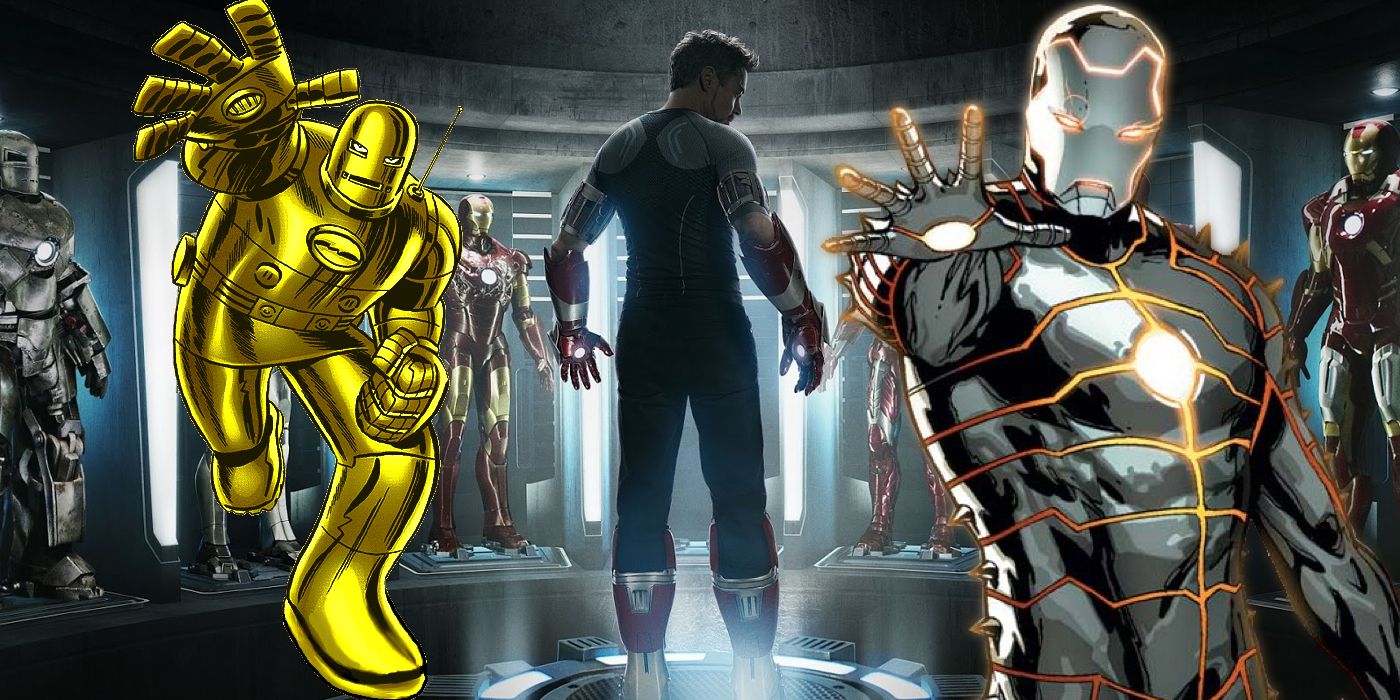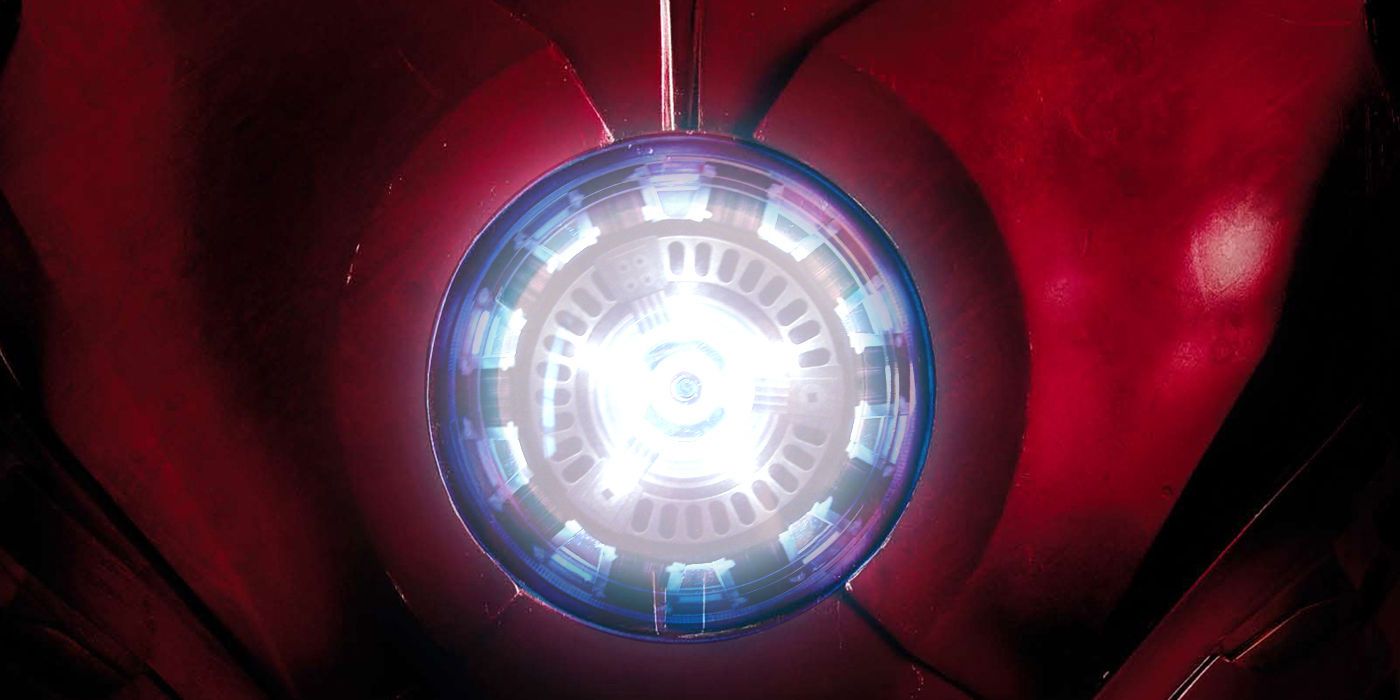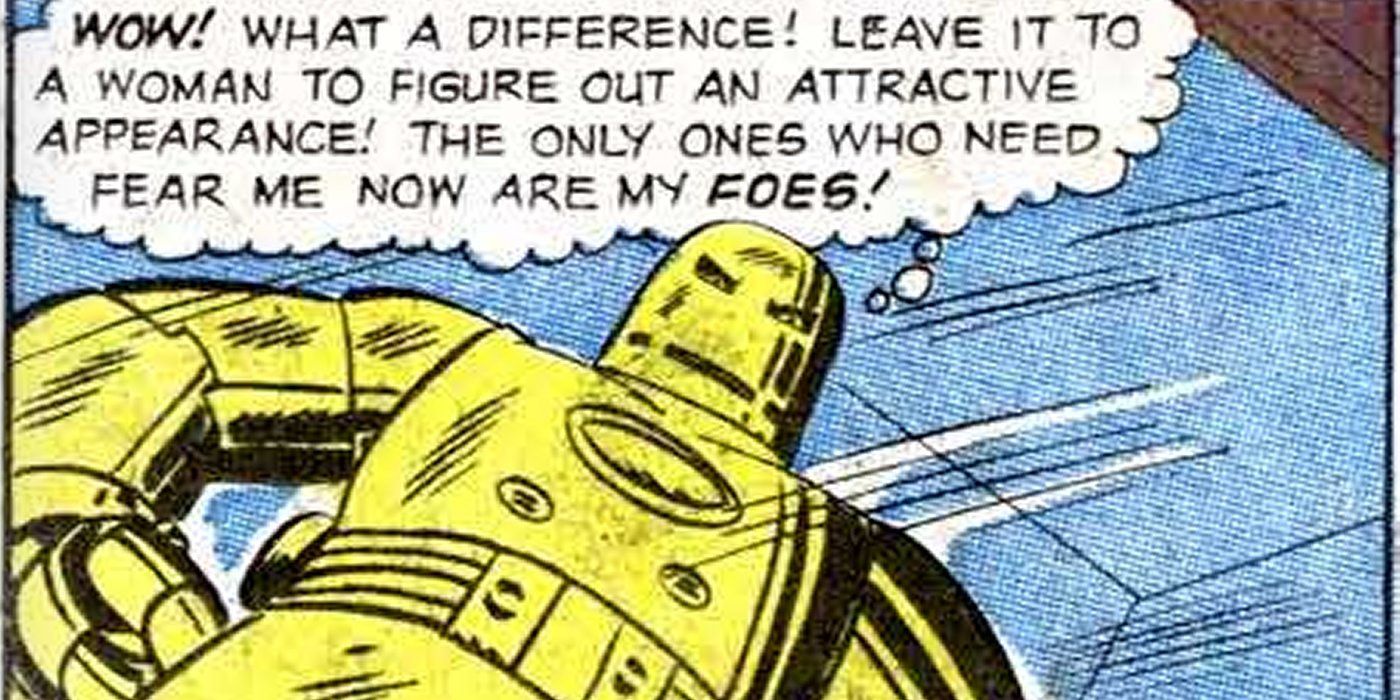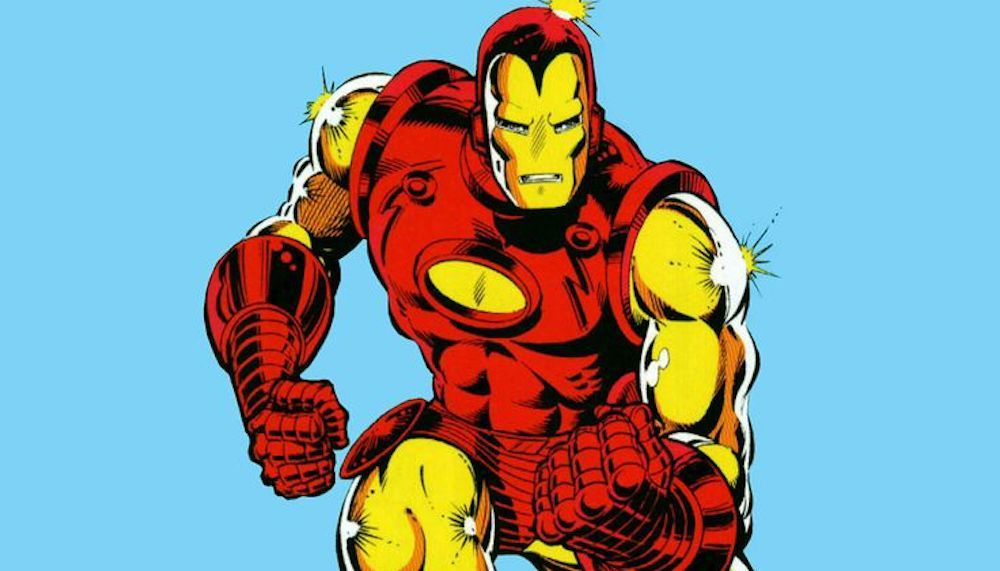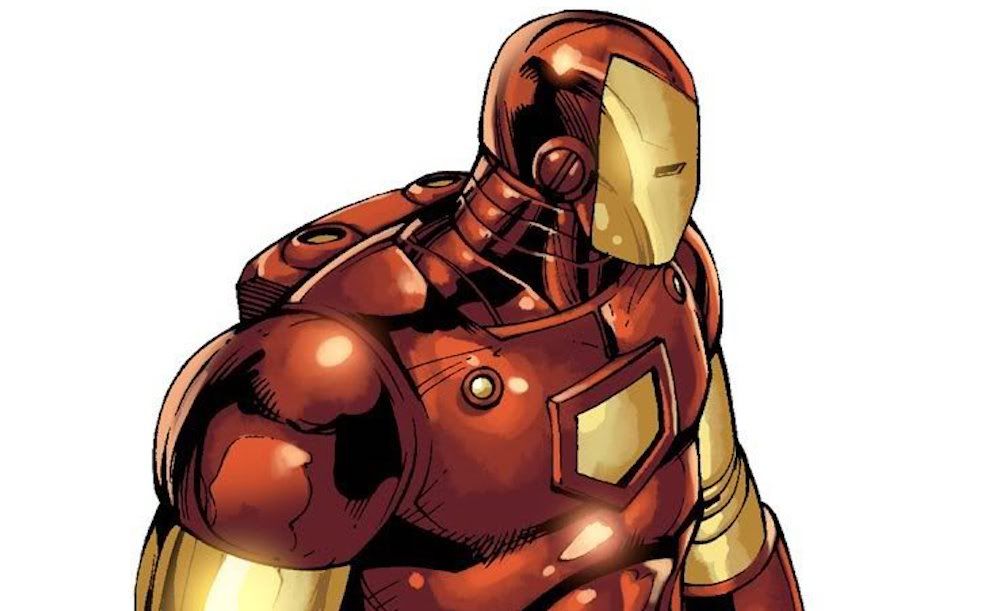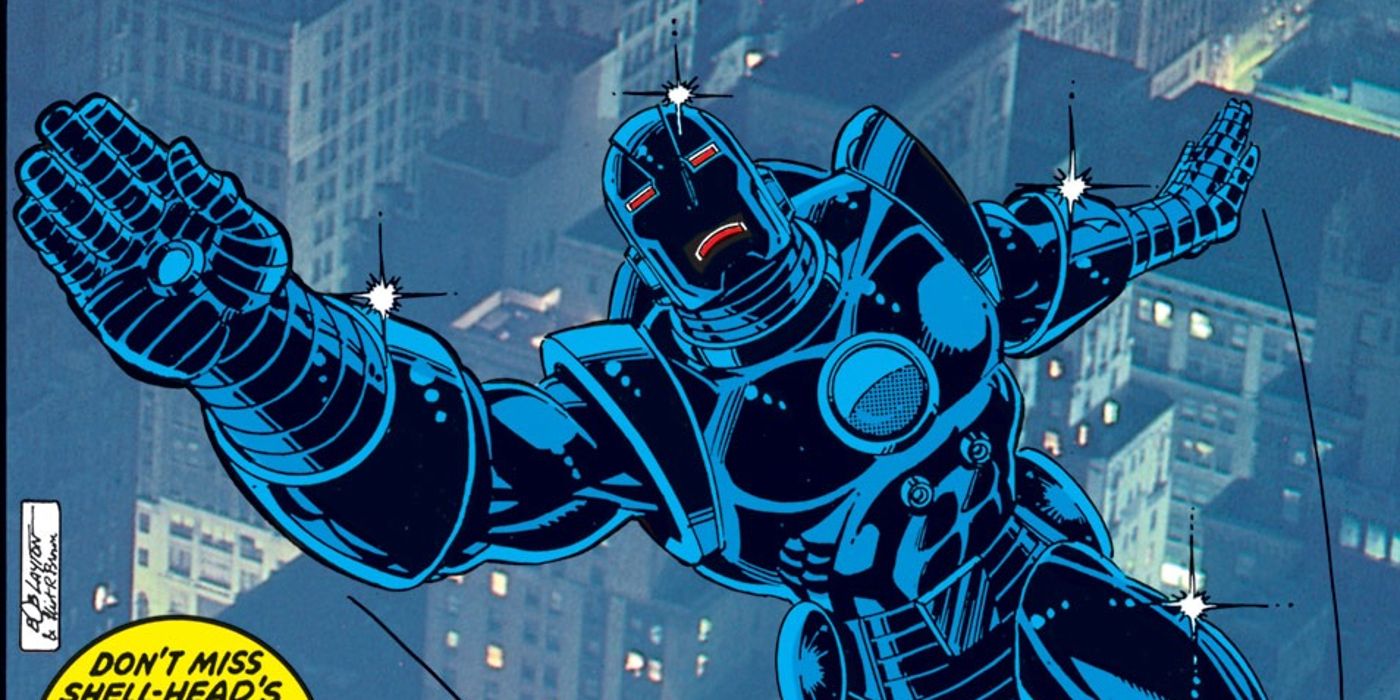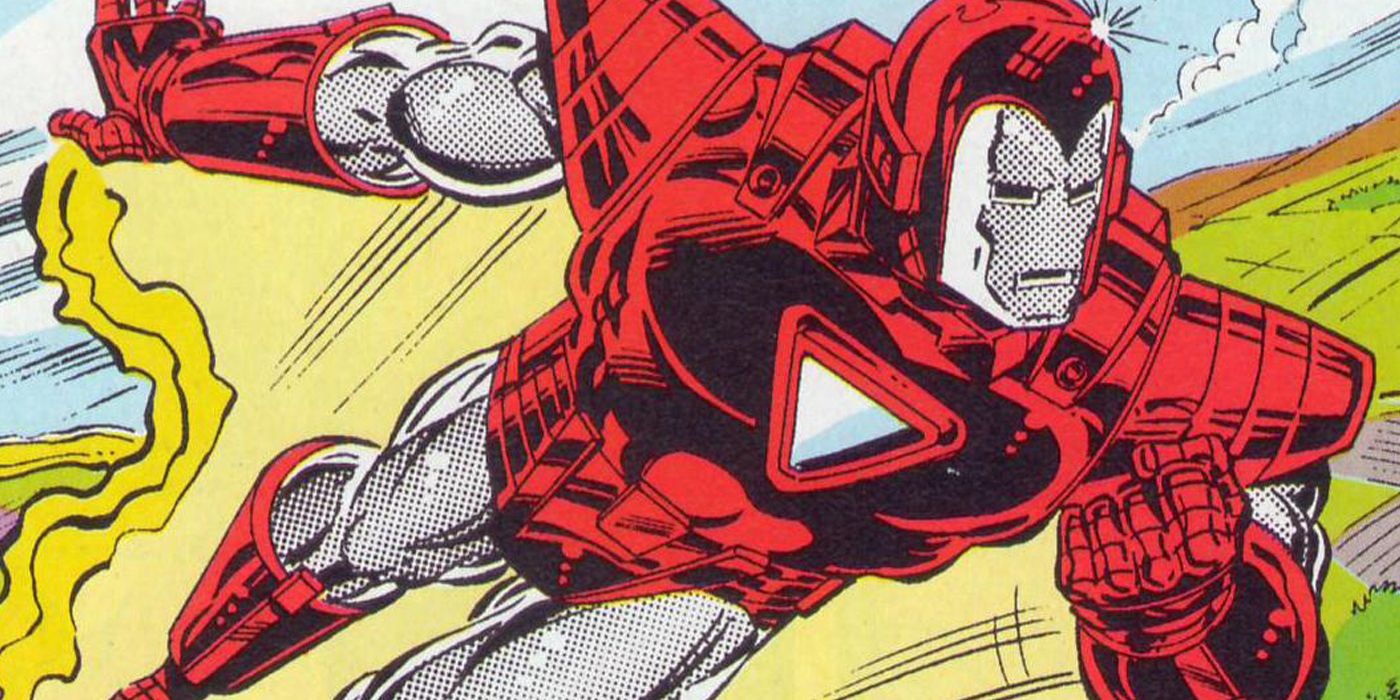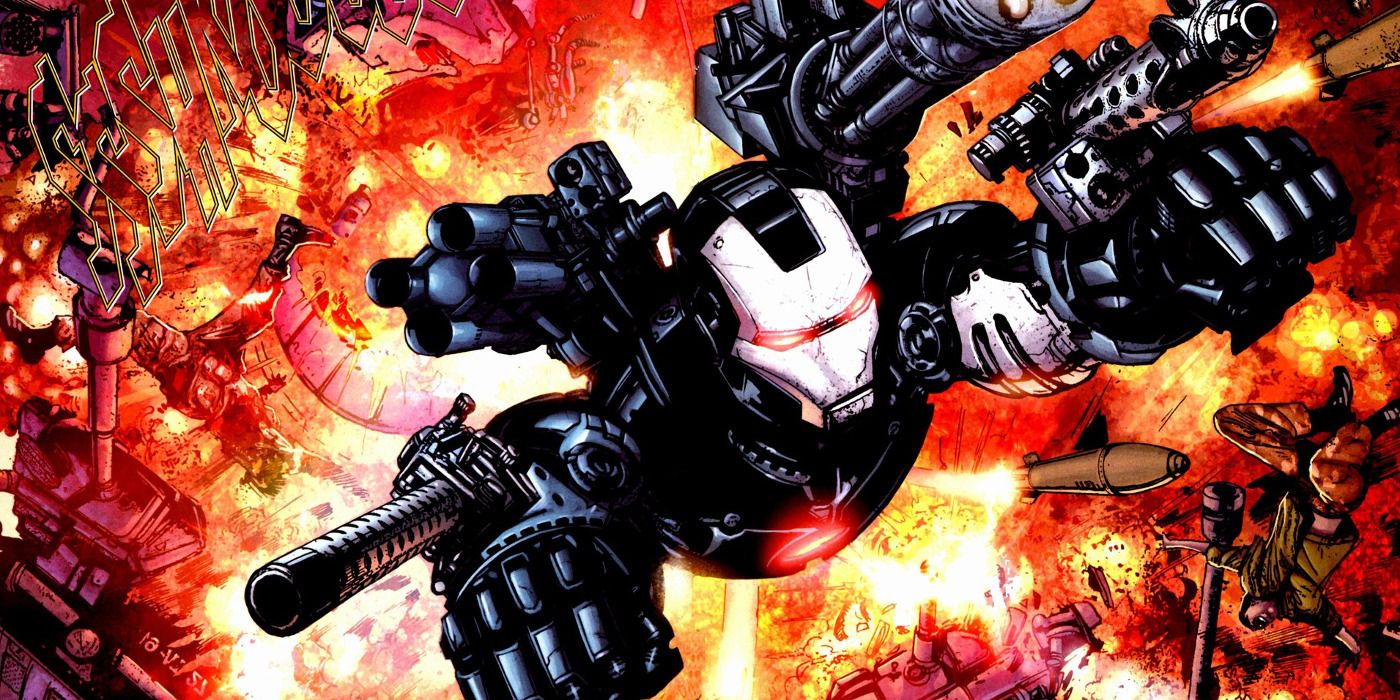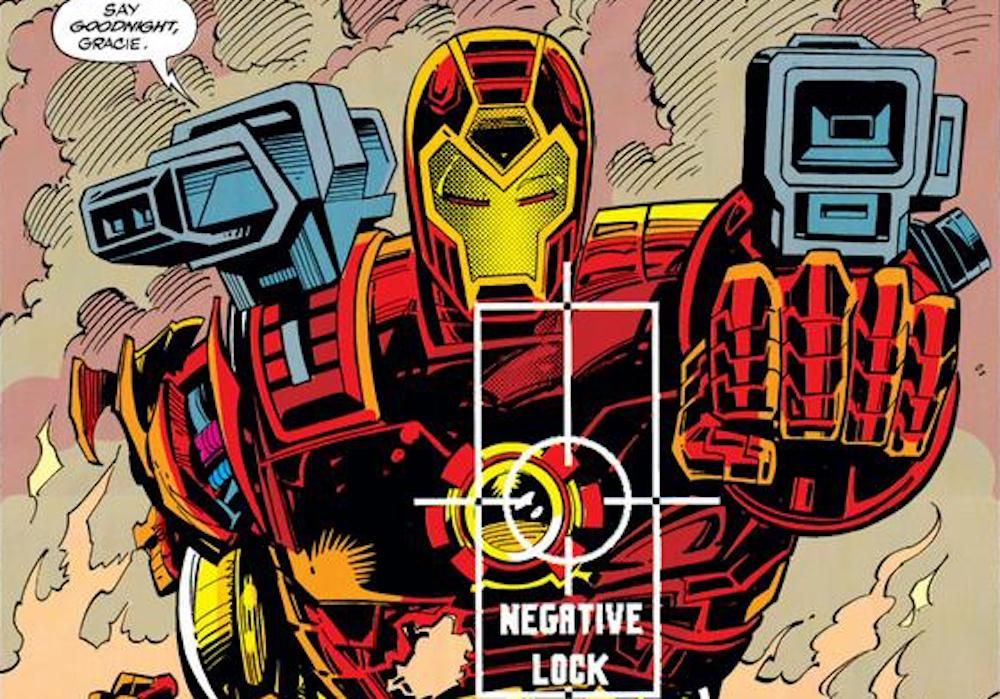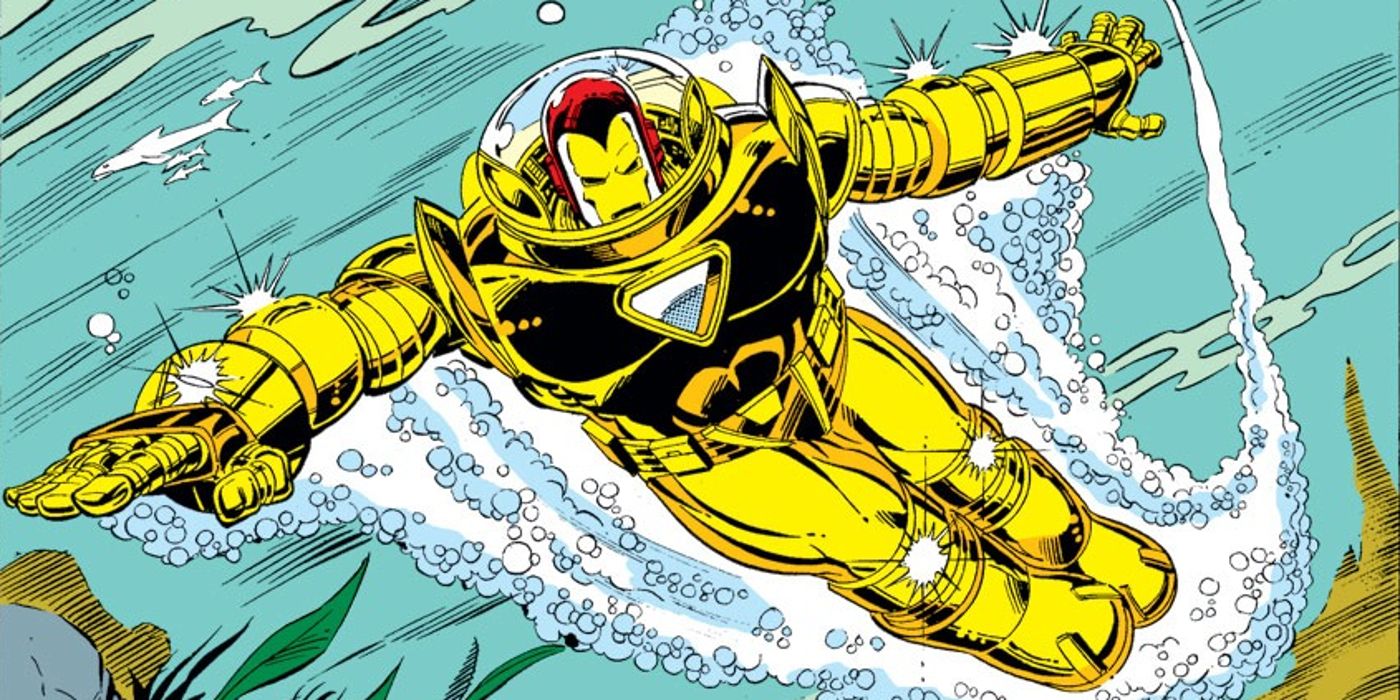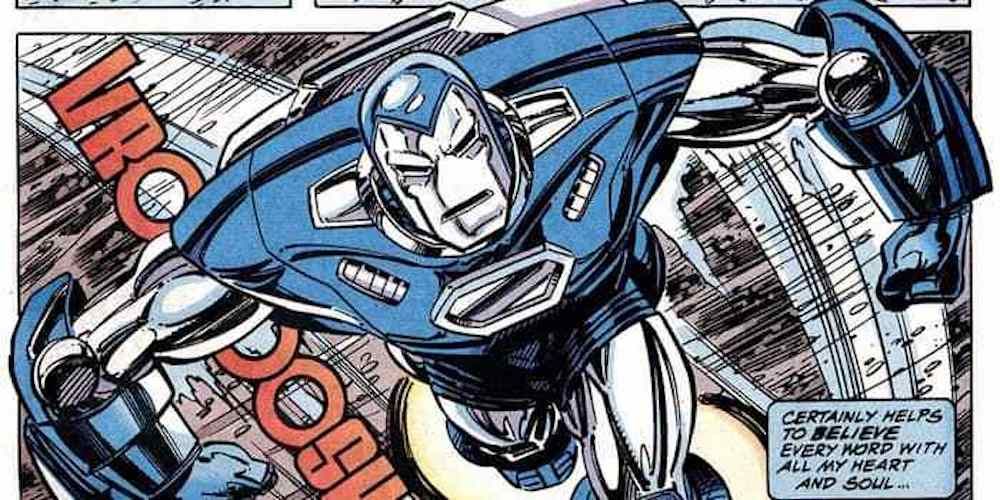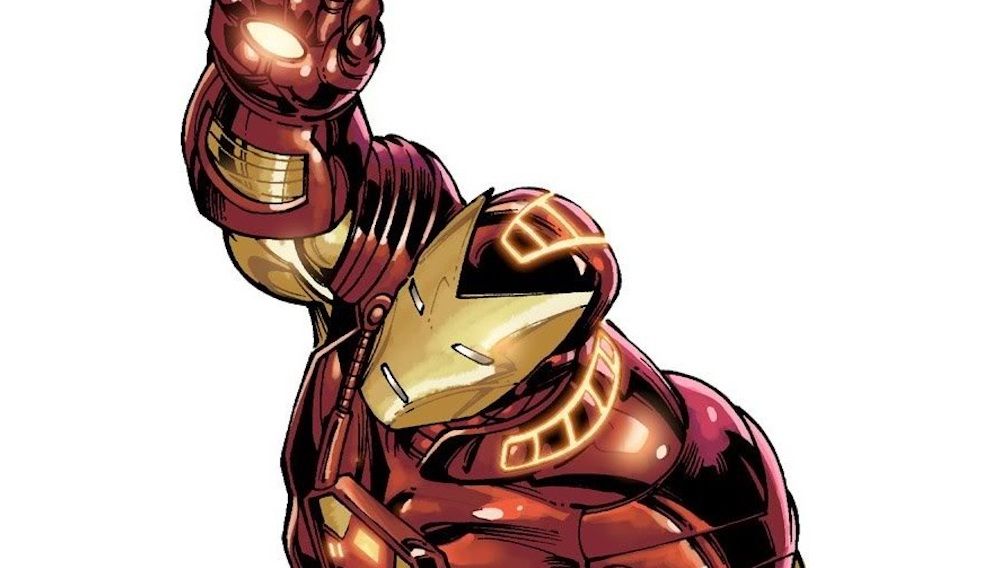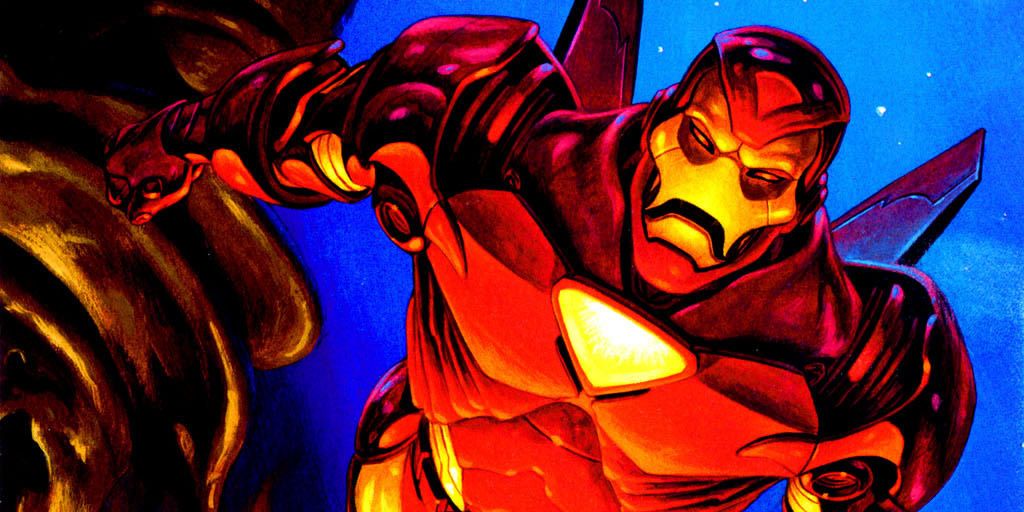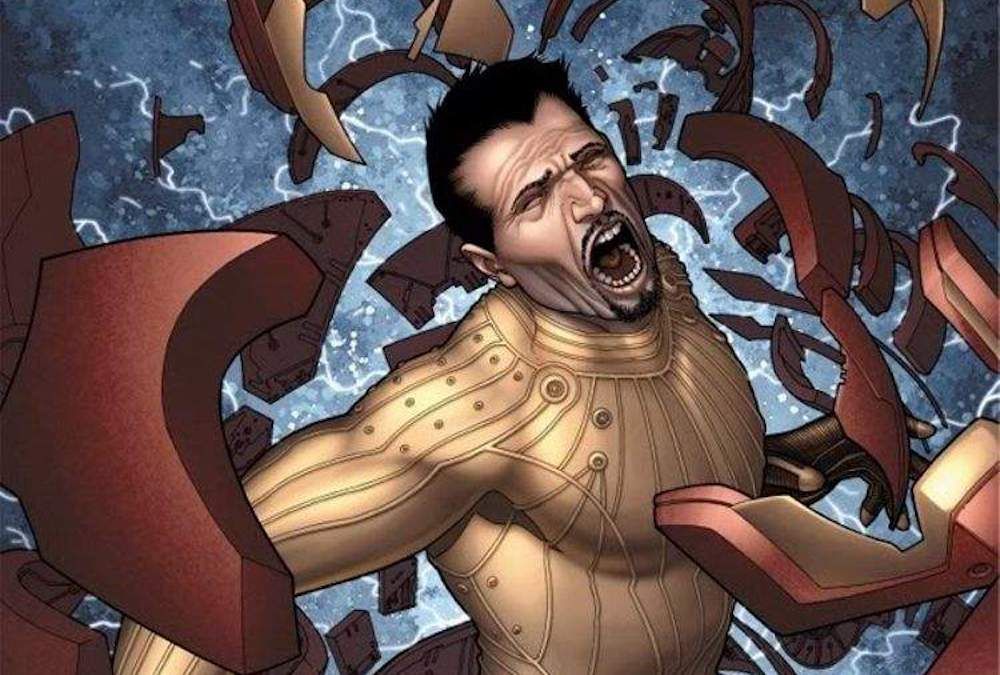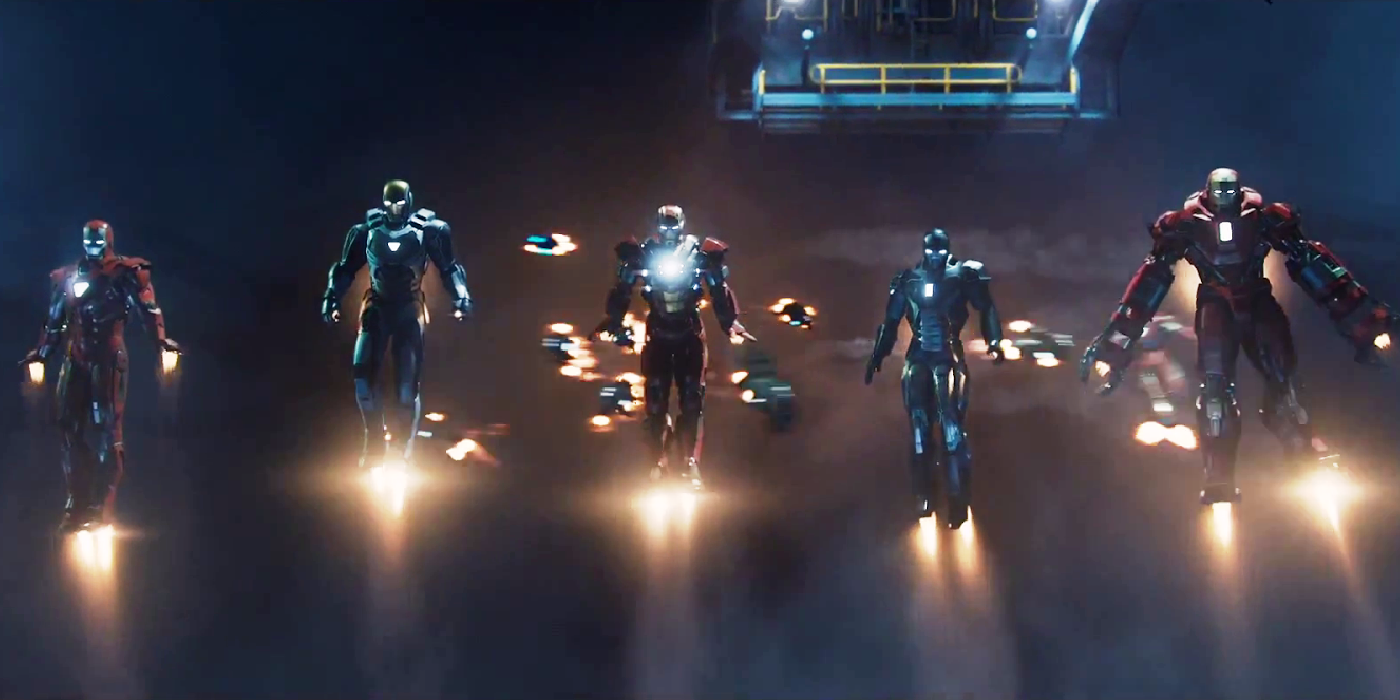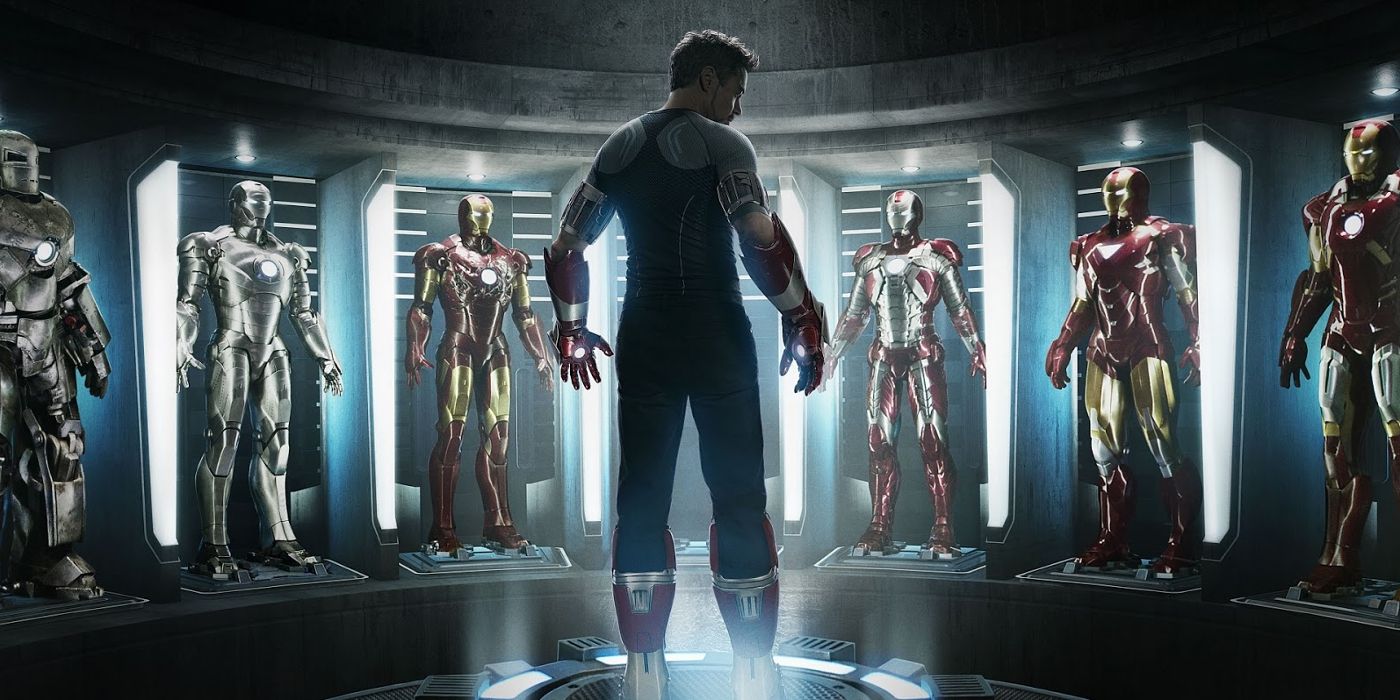Iron Man has worn a number of suits over the years, from the clunky silver contraption introduced in Tales of Suspense #39, to the sleek, modern Adi Granov design from the 2008 movie Iron Man. Broadly speaking, they all have the same functionality. Jets in the boots allow flight, and the repulsors in the gloves along with the unibeam in the chest are used to attack Tony Stark’s enemies. As such, you’d be forgiven for thinking there’s not much to else to the suits.
However, not every suit has the same functionality, and some of the enhancements installed over the years are surprising. From catheters to finger lasers, armor-making bacteria to unconvincing camouflage technology, there have been a variety of approaches to the Iron Man armor. Here, then, are 15 Things You Didn't Know About Iron Man's Suit.
15. Like any electrical appliance, it’s charged by a singular power
The Iron Man suit is an advanced piece of equipment, capable of flight, strength enhancement, and carrying a large array of different weapons. However, the silver suit from Iron Man’s first appearance in March 1963 ran on fairly conventional DC motors. As such, Tony Stark had to plug it in for charging between missions. The gold armor, introduced in his second appearance, added the capability to be recharged by solar power, and the original red and gold Model 2 from December 1963 was more power-efficient, but ultimately, its power supply technology was not too dissimilar to any household appliance.
Later armors had more demanding power needs. The Model 4 armor in April 1976 was fully solar, and could convert excess temperature into power. The Model 5 Space Armor from January 1981 was the first to use nuclear power, and the Model 9 from June 1988 was the first to run on a betavoltaic battery. Currently, the suit is charged by Stark’s chest-mounted arc reactor, as established in the 2008 movie Iron Man.
14. The original armor had a tape recorder
Obviously, computers weren’t commonplace back in the '60s, and the idea that one would be a core component of the armor didn’t occur Iron Man’s creators, writers Stan Lee and Larry Lieber, and artists Don Heck and Jack Kirby. Therefore, earlier versions of the suit contained technologies that were perfectly reasonable for the day, that now seem quaint at best.
For example, the current Iron Man has access to GPS and video calls, as demonstrated in Spider-Man: Homecoming. However, the original gold suit from April 1963 had to make do with radar and a short-wave radio. The principle’s the same, but the suit is ultimately a little less advanced exoskeleton, and a little more flying submarine. The suit also featured a tape recorder, which begs the question of where, exactly, Iron Man stored the tapes.
13. The suit had tongue-operated helmet switches
We’re used to the idea that Iron Man’s suit is basically a wearable iPhone with repulsor rays. However, earlier versions were much more mechanical. The classic red-and-gold Model 2 suit didn’t have an on-board HUD and accompanying AI, didn’t respond to voice controls – it didn’t even have integrated micro-circuits (introduced in Model 4, April 1976). Instead, all of its functionality was activated either by wrist-mounted controls, or by switches in the helmet, operated by Tony Stark’s tongue. This seems like a particularly dexterous feat by Mr. Stark, and offers a very specific insight into his character.
Telepathic armor control was introduced in March 1993, with the NTU-150 Telepresence Armor, and the S.K.I.N. armor from July 2001 featured a cybernetic interface.
12. The suit had a voice distorter and finger lasers
One of the gags in Spider-Man: Homecoming comes when Peter Parker activates a voice changer in his suit in order to intimidate Aaron "the Prowler" Davis, played by Donald Glover. This has a strong basis in Iron Man lore. The Model 4 armor introduced the concept of a voice distorter, installed to duplicate sounds as well as protect ol' Shellhead’s secret identity. One imagines it took on a more robotic quality, rather than following the example of Christian Bale’s Batman voice, but since it was depicted in the comic book medium that decision’s somewhat up to the reader.
Other features of the Model 4 suit include its finger lasers, which are used to cut through objects, and a hologram emitter, which allowed Iron Man to project decoy suits to make him harder to target.
11. The Space Armor had a catheter
Iron Man’s armor was originally built as a life support machine, to prevent a piece of shrapnel from entering Tony Stark’s heart and killing him. However, some models were designed to support Iron Man for extended periods away from home. The Space Armor (Model 5), for example, had life support powered by liquid oxygen, contained two day’s food supply, and was installed with a catheterization system in order to process that food out the...other end.
Another notable space armor is Model 27, designed to withstand as much as 50G in the increased gravity conditions of hyperspace travel. This armor is best known for its massive knee-high boots. The most recent version of space armor is Model 45, built for Tony’s time with the Guardians of the Galaxy.
10. Stealth Armor had camouflage (for environments of one color)
Tony Stark is not necessarily known for his subtlety. Nevertheless, there are quite a few models of stealth armor in the collection. The first, Model 7, from November 1981, was a black armor with no weapons, but could absorb or jam radar, sonar, and ECM. Later upgrades added three-shot-only repulsors, and a camouflage ability. It could only work in mono-color environments such as snow, though, which is of limited use.
A later stealth armor, Model 21 from July 2002, could achieve full cloaking through an optical fibre network running to its movie screen-like surface. It was completely non-metallic, and was made out of ceramics and a Kevlar-like material. Model 43 from February 2013 is the most recent stealth armor, and could bend light for camouflage, disguise itself with holograms, and featured non-lethal silent weaponry.
9. The Silver Centurion was a headache
Like the stealth suits, the Silver Centurion armor (Model 8, November 1985) could camouflage itself. This model had a chameleon field, which would create a hologram based on its surroundings which would render it invisible both to cameras and to the naked eye. However, the feedback generated by interference with the cybernetic controls resulted in headaches, which is less than ideal.
This armor was initially meant to be worn by James Rhodes, War Machine, but it never got handed over. Each of its constituent parts contained a small emergency charge, and the suit included Freon streams and a force-field, which consumed a lot of power, so couldn’t be left on for long. It could also recycle air, water, and nutrients, so Stark could stay inside indefinitely.
8. War Machine is Iron Man for the '90s
June 1992 was an interesting time in comics. With the rise of artists such as Rob Liefield, and the launch of Image Comics, the aesthetic of the day was guns, guns, and more guns. As such, the Iron Man team responded in kind and invented War Machine, the first armor to ditch the tried-and-tested repulsors and unibeam. The arms featured a twin-chain gun, a laser blade, and a wrist-mounted flamethrower. Ostentatiously installed on the shoulders were modular weapons, which could be swapped out for each other: Gatling gun, rocket launcher, and various cannons. These could fire a range of munitions, from tear gas to depleted uranium.
This armor was given to Tony Stark's pal James Rhodes, along with all subsequent iterations on the theme of guns, guns, guns.
7. Tony Stark isn't always in the suit
At one point, Tony Stark suffered too much nerve damage to allow him to don an Iron Man suit. So, he designed the Model 12 (March 1993), which could be operated by a telepresence system. Stark donned a headset and controlled the armor remotely. The lack of a human taking up suit space meant more room for weapons. Like War Machine, it had a shoulder-mounted Gatling gun and a micro-Rocket launcher, grappling wire, a taser, tear gas, and much more, alongside the traditional repulsors and unibeam.
However, the unibeam could be adjusted into a tractor beam, a search light, an EMP, or a variety of other effects. It also had an energy field, an absorption grid for energy attacks that converts them into power, and, of course, autopilot.
6. Some suits are not really suits
It could be argued that some of the most iconic and experimental armors were not individual models in the truest sense. For example, the Hydro Armor (Model 6, May 1987) featured the helmet of a Model 4 armor encased inside a dome, so for all intents and purposes, it looks like Stark is wearing a suit over the top of a suit.
More relevantly, Model 14 from issue 300 (January, 1994) was a fully modular design. The suit consisted of micro-scale tiles, which were made by genetically engineered bacteria depositing the metal shapes and electronic circuits. Modules included a magnetic railgun, microsurgery equipment, and an EM field generator. However, the most iconic module is the Hulkbuster armor, later featured in Avengers: Age of Ultron, specifically made to combat the Incredible Hulk.
5. The Arctic Armor was only used for one trip
As we can surmise from this list, the different incarnations of Iron Man armor were primarily designed for two reasons: plot, and an artist’s desire to draw something different. The most interesting redesigns combined both aspects – for example, the shift between the original, clunky Model 1 armor and the now-classic Model 2 armor. Cosmetically, this look was maintained (with occasional tweaks) from December 1963, through Models 3 and 4, until the Space Armor was introduced in January 1981. Even that model is broadly similar to the Model 2, maintaining its color scheme and the tweaks mainly being to its silhouette, so arguably the Hydro Armor from May 1987 was the first major departure from the Iron Man suit design in 24 years. It is only after this model that we see artists truly experiment with what the armor could look like.
Which brings us to Model 14, the Arctic Armor, which was only used for one trip to the Arctic in issue #318. Clearly, the artist just wanted to draw it. It was blue and silver, and it’s probably best forgotten.
4. Stark doesn’t have the best luck with armors
After returning from the Counter-Earth (don’t ask), Stark designed a brand new armor, Model 16 (February 1998). The big innovations this time round were an integrated cellphone and wireless modem. It had a chin toggle for drinking water, and was later upgraded with a force bubble projector, which could provide hamster ball-like protection for civilians. It was designed by comic book legends Alex Ross and Kurt Busiek. Unfortunately, he had to retire the armor after he found out that it, and all the armors before it, were negatively effecting his health, due to the intensity of its electronic components.
After a test Model 17, Stark managed to make a safe armor. Unfortunately, this became sentient, after being infected by the Ultron Imperative, killed Whiplash, and tried to kill Stark as he was frustrating its attempts to merge with him permanently. He was reluctant to create a new armor for a little while after that.
3. Model 24 was created for his time as Secretary of Defense
When you get a new job, it’s entirely reasonable to get yourself a new suit to go with it. When Tony Stark began serving as the Secretary of Defense, he thought pretty much along the same lines, and created Model 24 (December, 2003). Apart from the occasion of its creation, there were few innovations in this model. It did feature a repulsor shield, which could protect the armor in combat, but it was still extensively damaged by acid exposure, forcing its retirement.
It was replaced by the similar Model 25, which featured voice command: on the word ‘assemble’, the armor would enter Battle Mode, allowing the suit to target enemies. It went into standby on the code word ‘quivers’. It was the last full-time armor worn by Stark before the introduction of Extremis.
2. With Extremis, Tony Stark is the armor
The Extremis armor (Model 29, March 2006) is a paradigm shift in the history of Iron Man. After injecting himself with a modified version of the Extremis virus, in order to recover from extensive injury, Tony Stark mutated into a cyborg. The undersheath of the suit is now stored in the hollows of his bones, and can grow around him from inside his body. This can repair damage to both body and armor, allow Stark to directly access satellite networks with his mind, and pilot multiple models of armor remotely.
Subsequent suits have relied on this genetic mutation to enhance the power and capabilities of the Iron Man armors. It was designed by Warren Ellis and Adi Granov in a storyline later adapted for Iron Man 3.
1. Movie Tony makes more suits, more quickly
Tony Stark is a prolific inventor of new Iron Man suits. Over the run of the Marvel Universe, he has created no fewer than 52 different Iron Man suits. This is not counting modifications to existing models, such as the original gold suit, modular additions such as the Hulkbuster, War Machine armors worn by James Rhodes, or outliers such as the Iron Spidey suit.
While that seems like a lot of armors, Iron Man has been around for 54 years at time of writing, so it works out as less than a suit a year. Conversely, the Iron Man of the Marvel Cinematic Universe has been around since 2008 and in those 9 years, he's already made 47 suits (excluding War Machine and Spider-Man), making the Robert Downey Jr incarnation much more prolific.
However, if you’re a fan of nerdy technicalities, there are ways of making the workrates of the two Tonys more comparable.
Bonus: Movie Time vs Marvel Time
There’s no full-proof way of dating the Marvel Universe, or the MCU, but there are some indications.
The majority of Spider-Man: Homecoming (2017) is set eight years after the Battle of New York in The Avengers (2012). For this to work, either the events of The Avengers took place before its release in 2012, or Spider-Man: Homecoming is set in 2020. There’s been no official word, and it might just be an oversight, but it does give us three years previously unaccounted for. So, we’ll posit for now that Movie Stark has invented 47 suits in 12 years, or 3.92 a year.
In the comics, there’s a different timeline issue, in that the Marvel Universe has been around since Fantastic Four #1, from November 1961, but the characters have not aged in real time. Instead, the entire timeline has been roughly compressed so that it’s currently 14 years since the Fantastic Four’s first appearance. This gives Comic Tony a workrate of 52 suits in 14 years, or 3.71 a year, which is much more comparable.
--
What's your favorite Iron Man suit feature? Let us know in the comments.

